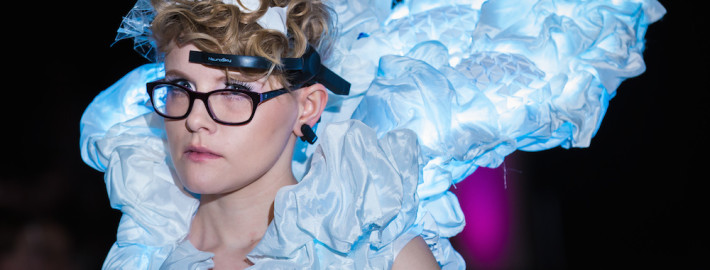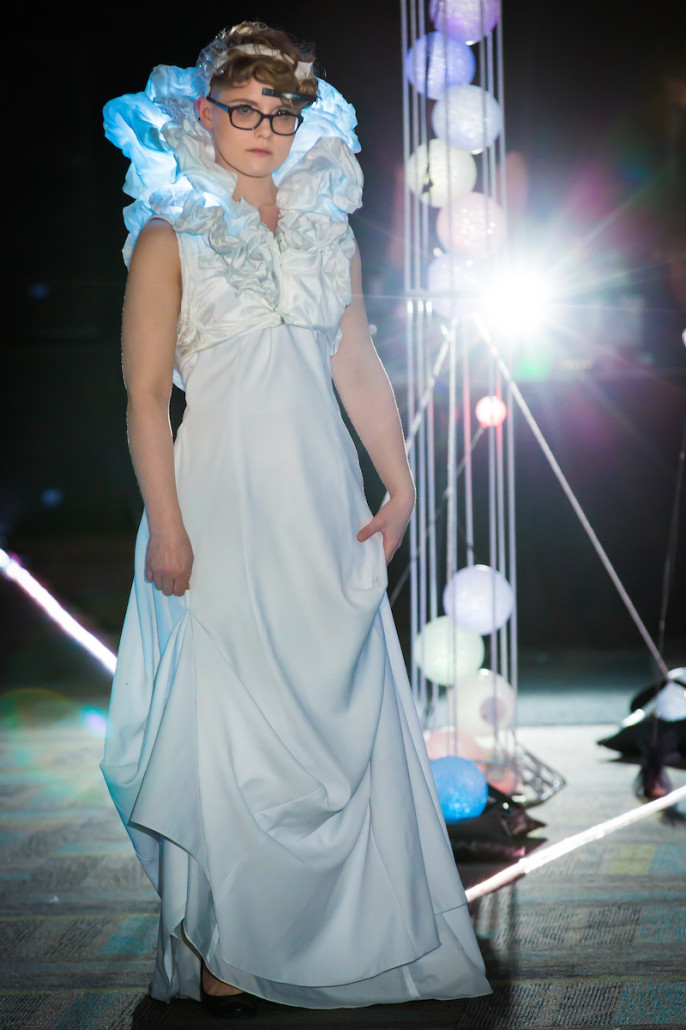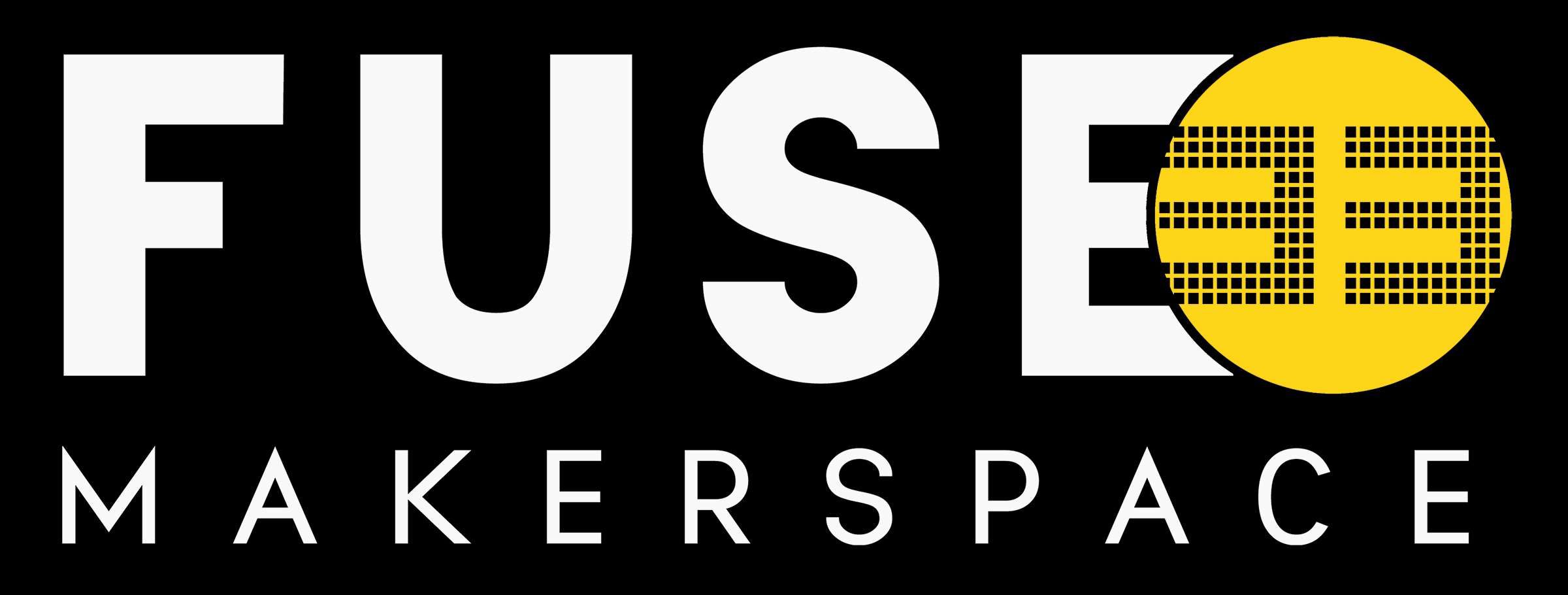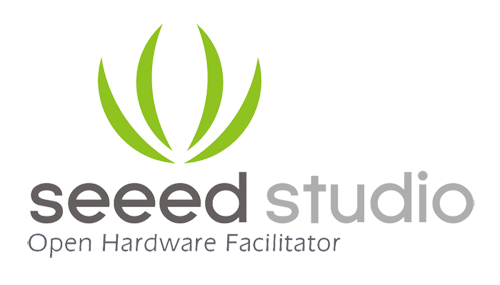MakeFashion Spotlight: Common Experience
MakeFashion Spotlight is an insider’s look on our 2014 gala pieces. Follow us as we showcase each of our designers and the inspiration and technology behind their work. Photos by Edward Ross photography.
Kathryn Blair and teammate Ryan Blair, creators of “Common Experience” are both from Calgary.
“I like that the maker and art communities in Calgary are very open and easy to get involved with. It’s also a city that’s changing a lot, and it’s exciting to be a part of that. I came to work with wearable technology via physical computing, which I’d worked with for some art work in the past. My first wearable project was for MakeFashion 2013. It was called “Somatic System” and it was a coat that used a temperature sensor and a pulse sensor to monitor the wearer’s mood. It would then change colour and play music to correct (calm) a bad mood, or maintain a good mood.
You could totally commercialize a headband that would tell the world how much attention you’re paying, but it would be so scary!
I’m very interested in biofeedback and exploring the intersection between mind and body – it’s so easy to think about your mind as a separate entity from your body, and easy to think about your mind in other context – identifying with other people, imagining what it would be like to be different. That’s totally vital for our ability to empathize with others. But our minds are a part of our bodies, and our bodies have a huge impact on how we think and feel, both the physical reality of our brain, and the physical reality of other parts of our bodies, and of course external stimuli also impact our brains. I love exploring those intersections, and wearable technology and EEG provides an amazing set of tools to do that.
The technology used in Common Experience includes:
- Neurosky Brainwave Starter Kit (http://store.neurosky.com/products/brainwave-starter-kit)
- Raspberry Pi (https://www.sparkfun.com/products/11546)
- Programmed in Python
- The python-mindwave-mobile library: https://github.com/robintibor/python-mindwave-mobile
- RGB LED strips (like these): http://www.aliexpress.com/item/waterproof-RGB-LED-strip-light-SMD-5050-LED-strips-DC12V-SMD5050-60-led-M-5M-roll/1309890652.html?s=p
- Hobby servos like these http://www.hobbyking.com/hobbyking/store/__662__HXT900_9g_1_6kg_12sec_Micro_Servo.html
- Lipo batteries – http://www.hobbyking.com/hobbyking/store/__9394__Turnigy_2200mAh_3S_30C_Lipo_Pack.html
When building Common Experience I worked with my husband, Ryan Blair, to figure out how to execute. I tend to get an idea and execute, and my revisions tend to be in the specifics and how I’m executing, rather than the idea overall. So of the basic idea, there was pretty much one draft. Of the specifics, there were hundreds of revisions of exactly how we should do things, how it should look exactly, what it should be made of. Many of the deciding factors were practical – will this work? Will it look good? Will it move the way I need it to?
I come at this more from a visual art background and having done programming and physical computing before, so I serve as my own technical support on the programming side, and my husband Ryan is great with electronics. I also got some help from Dave at Solarbotics, and on the fashion end, from Julia Wasilewski, a costume designer.
Rather than use a model, I chose to wear the piece myself! I was very focused on getting down the runway okay and trying to keep my timing decent. I like to model my pieces myself because for me it’s kind of about that relation / intersection between wearer and garment. We had a great movement coached who helped me figured out a way to model it theatrically. She was great and very helpful!
Using the EEG (the input sensor) is the real wow factor of the piece. It’s so amazing that you can buy an EEG for $130 and read the data from it and use it to make crazy projects – nerf guns that fire based on your brainwaves, for example (http://hex-machina.com/hw/mindbullets). I used the EEG output – the attention level of the wearer – to control the colour of the lights on the garment, as well as to move servos, which pulled origami deployable structures into different states of tension.
This year I learned a lot of programming and I’ve never worked with servos or Raspberry Pi (or linux) before, but I think one of the most useful things I learned was about my personal process – I love to play with materials and test out different options, and I can put off making decisions (and spending significant money on materials) until I absolutely have to make that decision. My advice to new designers is to play with whatever technology strikes your fancy. Never wonder if you can accomplish something – see if you can find a way to do it before you dismiss it.
I think a lot of the body-monitoring biometrics is starting to become big, and starting to integrate, and I think that will get really all-encompassing and able to make better inferences about your body’s state and suggestions about what you should do, and it will be popular among the very health-conscious.
You could totally commercialize a headband that would tell the world how much attention you’re paying, but it would be so scary – who wants everyone to know if you’re not paying as much attention as they would want you to? I hope that doesn’t happen, so big-brother-ish.
You can reach me via my website, http://glass-slipper.net, or on facebook at http://facebook.com/kath.blair, or on twitter at @kathblair.
– Kathryn Blair, returning designer for MakeFashion two years in a row.
The 2014 MakeFashion gala brought to you by OnConference in March 2014 had over 400 attendees and showcased an inspiring collection of local and international wearable technology. E-mailinfo@makefashion.ca for information on how to become involved as a volunteer, designer, tech enthusiast, or sponsor.








Leave a Reply
Want to join the discussion?Feel free to contribute!